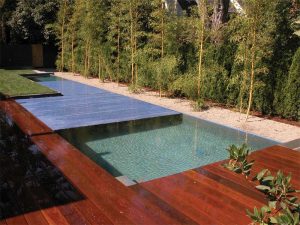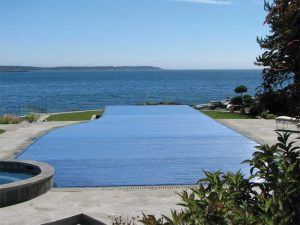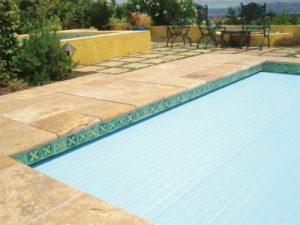While still considered a niche component of the pool, automatic covers are gaining popularity thanks to their ability to reduce the operating costs of a pool and/or spa with the rising costs of energy, and water consumption in arid climates. In fact, for many builders, the automatic cover is as an important piece of equipment as the pump and filter, and they include them in their bids to clients.
For decades, the standard in the U.S. and Canada was the traditional type of automatic pool cover that required the use of tracks and leading edge extrusions. While these covers could be installed on new or existing pools, they were always in the shape of a rectangle. Therefore, this requirement limited designers, builders, and homeowners with regards to the overall watershape.
Enter the slatted pool cover
While slatted pool covers have been the standard in Europe for more than three decades, they were only imported domestically as one-offs and, as such, most of the industry did not know they existed. That was roughly until 2001, when they started to be marketed and manufactured in the Americas as a viable option for the pool and spa/hot tub industry.

On larger pools, sometimes a combination of two or three systems can be used to provide full coverage of the water surface.
In addition to hollow core slats, solid (closed-cell foam) core slats are also available. The former are available in a wide range of colours and types, while the latter are extruded out of polyvinyl chloride (PVC). The popular solar slats are a co-extrusion, and are made from polycarbonate (PC).
Water shaping has recently taken on an expanded art form—especially with overflow (Lautner-type edges) vanishing-edges, and other unique rectilinear designs. The slatted pool cover is ideally suited and can provide automation on all of these pool types, as they can be installed in many more applications. In fact, on larger vessels, sometimes a combination of two or three systems can be used to provide full coverage of the water surface. On the other hand, track-type pool covers can only be installed at one end of the pool (either recessed as a new construction, or deck-mounted as a retrofit).
Unique installation possibilities

This pool has four main elements in its design: zero-edge, vanishing-edge, raised-beam (from the spa/hot tub), and converging shape. It is also exposed to the elements; therefore, the client was adamant about having a pool cover. A standard bubble cover was not an option. In this case, the slatted system worked perfectly for this pool design and, at the same time, is a visual enhancement as well.
In the traditional mount, if the pool is a skimmer type, the installation specification calls for a stainless steel beam to carry the load of the front of the masonry that is used to conceal the pool cover recess. This beam can be covered with tile to provide a cohesive finish with the cover deploying through a small slot beneath the lid.
For pools without a straight end or side, e.g. dual roman ends, oval, freeform, or a perimeter overflow, the most effective installation method is from an ‘in-floor’ position. This type of application can be from any position in the pool floor; however, the only condition is the floor must be level in that area.
The in-floor cover is hidden by a hydraulic-powered lid made of 316L stainless steel and is engineered to accept any pool finish for a virtually seamless appearance, assuming the pool is open (uncovered). When the key is turned to close the cover, the in-floor lid opens. Once it is completely open, a drum mechanism rotates to deploy the pool cover slats. These systems are also equipped with a limit switch to shut the system down in the open and close end of travel.
The most unique attribute of the slats is they can be cut to any converging shape and, therefore, can match a radius end. This ability provides automation on pool designs that previously could not accept an automatic cover. Another benefit is esthetics; with cutting-edge contemporary designs, the clean lines are pleasing to the eye in function and form.
Slatted pool covers eliminate the confines of symmetrical designs
Return on investment

In the traditional mount, if the pool is a skimmer type, the installation specification calls for a stainless steel beam to carry the load of the front of the masonry that is used to conceal the pool cover recess. This beam can be covered with tile to provide a cohesive finish with the cover deploying through a small slot beneath the lid.
Commercial pool market
A growing segment of the cover market comprises commercial pools. These facilities are usually too large (typically in width) for track-type automatic covers. A slatted cover, however, can easily run a combination of systems in a side-by-side configuration. For new construction, these pool cover systems can be designed into the aforementioned recessed application. When dealing with an existing pool, then the likely installation method for these covers is a deck-mounted drive. In some rare cases, the cover mechanism can even be mounted to and deployed from the ceiling of a commercial pool facility. Due to the fact some aquatic facilities are operated much longer than a residential pool (some 24-7), the ROI occurs much quicker, often within a year or two.
For some designers, builders, and homeowners, when comparing the different pool cover products available, the choice of which cover to specify becomes a decision made solely on the aesthetic value, and how the cover will impact the visual aspect. After all, the pool will always be covered, unless people are swimming, otherwise, what is the point of the cover? While traditional vinyl automatic covers are a great product with many attributes, they simply do not compare to slatted covers when it comes to visual appeal.
A security blanket
In addition to energy savings, safety and security concerns are often other reasons as to why homeowners install pool covers. While traditional track-type automatic pool covers are considered a safety product by virtue of meeting ASTM standard F1346-91(2010) for safety and closure, slatted covers do not meet this standard.
In Europe, however, slatted covers are considered a security device. That said, should someone fall on top of a slatted cover, it will not envelop them like a bubble cover would. Instead, it will keep them above water, albeit somewhat wet.
What a number of builders do is build a security ledge 51-mm (2-in.) below the waterline that will support the end of the cover should someone walk or fall on top of it. The ledge acts as a de facto track per se.
The manufacturing of all automatic covers is similar insomuch as they are all custom made to fit the pool and or spa/hot tub. These slats are capped and sealed at the factory prior to delivery. The drive units and cover take-up reels are also made specific to each project. Installation of the standard mount can be completed after the pool is built, whereas installation of the in-floor system requires a two-step install. First, all of the hardware has to be installed inside the vessel prior to applying the pool finish and second, floating the slats (laying the slats on the water surface to connect them for the final installation) once the pool is filled with water and is up and running.
This article was written by Tom Dankel and originally appeared on Pool & Spa Marketing [link].
